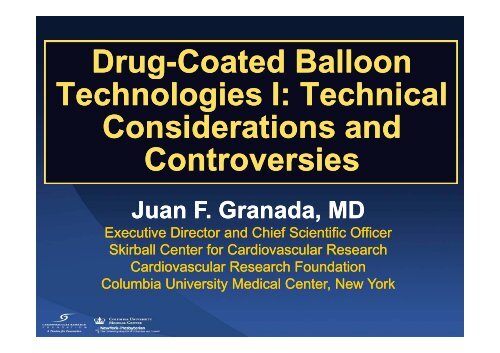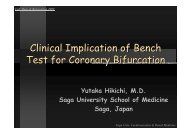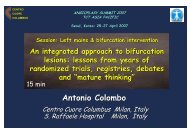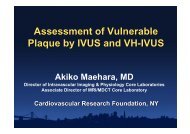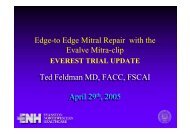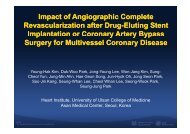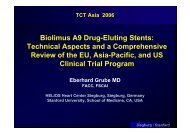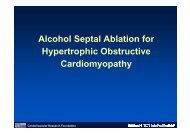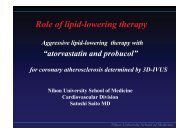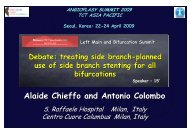Drug Coated Balloon Drug-Coated Balloon ... - summitMD.com
Drug Coated Balloon Drug-Coated Balloon ... - summitMD.com
Drug Coated Balloon Drug-Coated Balloon ... - summitMD.com
Create successful ePaper yourself
Turn your PDF publications into a flip-book with our unique Google optimized e-Paper software.
<strong>Drug</strong>-<strong>Coated</strong><br />
<strong>Balloon</strong><br />
Technologies I: Technical<br />
Considerations and<br />
Controversies<br />
Juan F. Granada, MD<br />
Executive Director and Chief Scientific Officer<br />
Skirball Center for Cardiovascular Research<br />
Cardiovascular Research Foundation<br />
Columbia University Medical Center, New York
Disclosure Statement of Financial Interest<br />
Within the past 12 months, I or my spouse/partner have had a<br />
financial interest/arrangement or affiliation with the<br />
organization(s) listed below.<br />
Affiliation/Financial Relationship<br />
• Grant/Research Support<br />
• Consulting Fees/Honoraria<br />
• Major Stock Shareholder/Equity<br />
• Royalty In<strong>com</strong>e<br />
• Ownership/Founder<br />
• Intellectual Property Rights<br />
• Other Financial Benefit<br />
Company<br />
• BSCI, Abbott, Medrad, Caliber<br />
• Medrad<br />
• VNT
Mechanism of <strong>Drug</strong> Delivery and<br />
Restenosis Prevention<br />
Can a drug delivered locally, only<br />
one time and without a controlled<br />
delivery system achieve long-term<br />
biological efficacy?
Mechanism of <strong>Drug</strong> Delivery and<br />
Restenosis Prevention<br />
BMS<br />
DEB 10s<br />
Effect of Carrier on<br />
Paclitaxel Transfer<br />
Cremers B. Thromb Haemost. 2009 Jan;101(1):201-6<br />
“Hydrophilic Carriers<br />
Increase Paclitaxel<br />
l<br />
Transfer”<br />
<strong>Coated</strong><br />
<strong>Balloon</strong><br />
Taxus<br />
Long Term Healing<br />
Cremers B. Cath Cardiov Int. April 2012
PACCOCATH ISR– F/U 5 Years Follow Up<br />
ISR<br />
Long-Term Follow-Up After<br />
Treatment of Coronary In-Stent<br />
Restenosis With a Paclitaxel-<br />
<strong>Coated</strong> <strong>Balloon</strong> Catheter<br />
Scheller B, JACC Intv 2012;5:323-3030<br />
4 Years F/u<br />
45<br />
40<br />
35<br />
Target Lesion Revascularization<br />
38.9<br />
37 37<br />
Per rcentage<br />
30<br />
25<br />
20<br />
15<br />
PCB<br />
Control<br />
10<br />
5<br />
0<br />
9.3<br />
4<br />
6<br />
12 Months 2 Years 5 Years
PCB Efficacy in BMS-ISR is<br />
Reproducible in FIH Clinical Trials<br />
In- -Segment<br />
Binary Restenosi<br />
s (%)<br />
0.9<br />
0.8<br />
0.7<br />
0.6<br />
0.5<br />
0.4<br />
0.3<br />
0.2<br />
0.1<br />
0<br />
-0.1<br />
86% RRR PEPPER Study (Biotronik)<br />
0.80±0.79<br />
PCB<br />
Control<br />
(Taxus)<br />
0.45±0.68<br />
• 81 patients<br />
• 47% DES-ISR.<br />
• LL: 0.07 mm.<br />
55% RRR 126 Patients<br />
BMS-ISR= 52%<br />
DES-ISR= 48%<br />
ISR + SV (< 2.5mm) 54%<br />
ISR + Bifurcation 29%<br />
0.31±0.22<br />
0.20±0.45<br />
0.16±0.40<br />
0.11±0.44<br />
N= 23<br />
N=54 N=54 -0.02±0.50 002 0 0<br />
N=66 N=65 N=39 N=34<br />
PACOCCATH I/II INPACT ISR PEPCAD II PERVIDEO I Spanish Registry<br />
(Medrad) (Medtronic) (BBraun) (Lutonix) (Eurocor)
Impact of <strong>Drug</strong> Retention (PK) on<br />
Vascular Toxicity and Efficacy<br />
)<br />
clitaxel<br />
n (ng/mg)<br />
rterial Pac<br />
centration<br />
Ar<br />
Conc<br />
Paclitaxel-Eluting Stents in Clinical Trials<br />
100<br />
Typical DEB<br />
Curve<br />
5<br />
Formulation A<br />
DES<br />
IMPROVE<br />
EFFICACY<br />
Formulation B<br />
DES<br />
TOXIC<br />
EFFECT<br />
THERAP PEUTIC<br />
WIND DOW<br />
1<br />
0<br />
0<br />
REDUCE<br />
COMPLICATIONS<br />
25 50 75<br />
100<br />
Time (Days)<br />
NO EFFE ECT
Local Tissue Effects (Safety)<br />
Vascular Healing According to Dose<br />
1= Minimal<br />
2= Slight<br />
3= Moderate<br />
4= Marked<br />
5= Massive<br />
Uncoated<br />
Mean Sc core<br />
2.5<br />
2<br />
15 1.5<br />
1<br />
0.5<br />
0<br />
Delayed Endothelialization<br />
2.17<br />
1 1<br />
1.75<br />
Mean Score<br />
2.5<br />
2<br />
1.5<br />
1<br />
Fibrin (Endothelial + Medial)<br />
0<br />
Control 2x 4x 6x Control 2x 4x 6x<br />
1<br />
0.5<br />
1.2<br />
1.7<br />
1.95<br />
Cotavance<br />
(1x)<br />
Cotavance<br />
(6x)<br />
Mean<br />
Score<br />
3<br />
2.5<br />
2<br />
1.5<br />
1<br />
0.5<br />
0<br />
IEL Rupture<br />
2.5<br />
2 2<br />
1.62<br />
Control 2x 4x 6x<br />
Mean Score<br />
3.5<br />
3<br />
2.5<br />
2<br />
1.5<br />
1<br />
0.5<br />
0<br />
Presence Amorphous Material<br />
2.87<br />
1.87<br />
1<br />
0<br />
Control 2x 4x 6x<br />
Histology picture obtained from CVPath
Mechanism of Action of DCB: Impact<br />
on <strong>Drug</strong> Retention and Embolization<br />
Acute <strong>Drug</strong> Transfer<br />
Micro-Particles<br />
Macro-Particles<br />
ng/m<br />
g<br />
1000<br />
0<br />
Luminal Surface<br />
Vessel<br />
1H Hour 24 Hour 7D Day 28 Day<br />
Acute <strong>Drug</strong> Transfer<br />
Tissue Transfer*<br />
~1 to 10%<br />
Distal Circulation*<br />
~60 to 70%<br />
• Most of Paclitaxel remains on the vessel<br />
surface<br />
• This “drug-reservoir” reservoir” creates a gradient<br />
and serves as the source for sustained<br />
drug delivery<br />
• Once the drug is transferred to the media<br />
of the vessel, tissue clearance depends on<br />
well described PK curves
Distal Washout of Paclitaxel Coating<br />
• 120 x 7 mm<br />
• Paclitaxel <strong>Coated</strong> <strong>Balloon</strong><br />
• ?% of Systemic Concentration<br />
• % of <strong>Drug</strong> Clearance?<br />
• % Chronic Tissue Retention?<br />
Distal Tissue Effect (Embolization)<br />
• Acute Ischemic Events (CLI)<br />
• Chronic Tissue Effects<br />
• Other Organs Toxicity
Paclitaxel Formulation Types<br />
Impact on Biological Performance<br />
Coating “A” Crystalline<br />
Coating “B” Amorphous<br />
Crystalline<br />
Amorphous<br />
Particles Released +++ ++<br />
Uniform Coating ++ +++<br />
<strong>Drug</strong> Transfer to Vessel +++ ++<br />
<strong>Drug</strong> Retention vs. Time +++ +<br />
Biological Effectiveness +++ ?
Tissue Transfer and Retention<br />
Crystalline versus Amorphous Coatings<br />
Tissue <strong>Drug</strong> Concentration (%)<br />
100.00<br />
50.00<br />
25.00<br />
EFFECTIVE<br />
Crystalline Coating 1: higher uptake,<br />
higher retention<br />
12.50<br />
6.25<br />
3.13<br />
3.06<br />
1.53<br />
0.77<br />
038 0.38<br />
0.19<br />
0.10<br />
Amorphous Coating 3: higher uptake,<br />
lower retention<br />
Crystalline Coating 2: lower uptake,<br />
higher retention<br />
1h 24h 7d 28d<br />
Time<br />
SAFE
Second Generations Coatings<br />
Paclitaxel <strong>Coated</strong> <strong>Balloon</strong> Technologies<br />
• Manual dipping process<br />
• Automated and controlled<br />
drug coating<br />
•Inconsistent D:E mixture<br />
•Improved coating mixture<br />
and uniformity<br />
First generation DCB<br />
technologies have already<br />
migrated into their second<br />
generation providing more<br />
precise coatings, tissue drug<br />
delivery and lower<br />
particulate count…<br />
•Limited scale production<br />
•Large scale reproducibility
Fact#1: Limited Evidence Based<br />
Medicine Leading to Clinical Practice<br />
RCT of PCB for the Treatment of De Novo SFA Disease (ITT= PTA Only)<br />
PACIFIER<br />
(Medtronic)<br />
LEVANT I<br />
(Lutonix)<br />
Fem-PAC<br />
(Medrad)<br />
N=45<br />
-0.05<br />
N=35<br />
N=39<br />
N=34<br />
N=31<br />
Thunder<br />
N=48<br />
(Medrad)<br />
N=41<br />
0.3<br />
0.46<br />
0.4<br />
0.61<br />
0.8<br />
1.09<br />
POBA<br />
PCB<br />
1.7<br />
-0.5 0 0.5 1 1.5 2<br />
Angiographic Late Loss (mm)<br />
“Still less than<br />
several<br />
hundred<br />
patients having<br />
6 month<br />
angiographic<br />
data and long<br />
term follow up”
Fact #2: PCB May Have Limited<br />
Efficacy in DES-ISR<br />
• DIOR II PCB Technology (3 µg/mm 2 )<br />
• 40.6% Diffuse ISR<br />
• Length Covered by PCB 24±9.1 mm<br />
• Follow Up: 228 ± 44 days (97.6% of Patients)<br />
BMS-ISR: 157 Patients.<br />
t<br />
DES-ISR: 83 Patients.<br />
Frequency of Stent Implantation 4.9%<br />
14<br />
12<br />
10<br />
8<br />
6<br />
4<br />
2<br />
0<br />
• In.Pact Falcon (Medtronic)<br />
13,4<br />
• 75 patients, 122 lesions 12,2<br />
9,8 • ISR 62.7%<br />
9,8<br />
• Diffuse disease 34.7% 7,2<br />
5,9<br />
• Death/MI/TVR: 13.3%<br />
• Angiographic 2,6<br />
2 Follow Up (63.9%):<br />
1,2 1,31,2 1,2 1,2<br />
• Restenosis 30.8% 0<br />
• DES-ISR: 47.5%<br />
• BMS-ISR: 0%<br />
• De Novo: 16.1%<br />
J Shannon, TCT-14, TCT2011<br />
BMS<br />
DES
Fact #3: A PTA <strong>Balloon</strong> is Not An Ideal<br />
Platform (A Stent May Be Needed!)<br />
Expansion mechanism leads to:<br />
• Expansion in path of least resistance<br />
• Significant shear stress and trauma<br />
• High dissection rate<br />
• Elastic recoil<br />
• Abrupt closure<br />
• PTA study (2002)<br />
• 74 patients<br />
• 43% major dissections<br />
• 32% residual stenosis >30%<br />
• ABSOLUTE: Stent vs. PTA (2006)<br />
• 104 patients, 1:1 randomization<br />
• 32% insufficient PTA result led to cross<br />
over to stent<br />
• RESILIENT: Stent vs. PTA (2008)<br />
• 206 patients 2:1 randomization 40% PTA<br />
cross over to stent due to flow limiting<br />
dissections and residual stenosis<br />
• Pacifier: DEB vs. PTA (2011)<br />
• 91 patients, 1:1 randomization<br />
• 21% and 35% bail out stenting due to<br />
flow limiting dissections and residual<br />
stenosis<br />
Acute failure reported in ~30 - 40% of PTA case requiring additional treatment<br />
Slide (modified) courtesy of Eitan Konstantino
Vascular Healing of BMS-PCB Combination<br />
Compared to Taxus Stent in Coronaries of FHS<br />
AS 21.5%* AS 29.6%* # AS 55.1% #<br />
PES<br />
2 nd<br />
nd Gen PCB + BMS<br />
p=0.01<br />
BMS<br />
*<br />
*p=ns<br />
#p
Primary Effectiveness Out<strong>com</strong>es<br />
Provisional BMS versus DES<br />
“It is possible that in selected cases and due to the<br />
scaffolding effect, peripheral p DES may be more effective<br />
than PCB…then if we are obliged to migrate into a<br />
<strong>com</strong>bined approach (PCB + BMS), PCB use will be<br />
restricted to longer lesions and smaller vascular territories”<br />
Dake M D et al. Circ Cardiovasc Interv 2011;4:495-504504
Fact #4: Sirolimus Analogues<br />
• Rapalogs provide well-established therapeutic benefit<br />
• Rapalogs provide high level of safety – DES “drug of choice”<br />
• PTX chosen for DEB because tissue transfer/absorption is far simpler<br />
• So why we do not use them?<br />
19
Paclitaxel Irreversibly<br />
Inhibits Arterial SMC<br />
Proliferation and Migration<br />
Using a Single Dose<br />
Tissue Distribution and<br />
Retention of Paclitaxel Make<br />
it an Ideal Agent for Local<br />
<strong>Drug</strong> Delivery<br />
Control (hSMC)<br />
(+) anti–ß-tubulin<br />
Sirolimus<br />
Paclitaxel l (hSMC)<br />
Paclitaxel<br />
(+) anti–ß-tubulin Dextran<br />
Axel DI. Circulation. 1997;96:636-645<br />
A. Levin et al., Proc NatlAcad Sci USA, 2004, 101,<br />
9463-9467.
<strong>Drug</strong> Eluting <strong>Balloon</strong> Nanoparticle Based<br />
(Sirolimus) )B <strong>Balloon</strong> Dilatation ti System<br />
Nanoparticle delivery technology<br />
• Enhanced tissue penetration<br />
• Protection from rapid degradation<br />
• Controlled and sustained release<br />
• Complete degradation<br />
Angioplasty balloon dilation system<br />
• Fully integrated <strong>com</strong>bination device<br />
•Semi-<strong>com</strong>pliant balloon<br />
• Full range of sizes and diameters<br />
Regular dilatation<br />
pressures plus Sirolimus<br />
nanoparticle delivery<br />
21 Slide courtesy (modified) of Caliber Therapeutics
Elution Control and Dose Feasibility<br />
Sirolimus Delivery Using a Porous <strong>Balloon</strong><br />
Tissue PK at 28 Days Following Sirolimus Delivery<br />
Slide courtesy (modified) of Caliber Therapeutics
Opportunities for Improvement<br />
SIROLIMUS<br />
DEB Nanoparticle Based<br />
<strong>Balloon</strong> Dilatation System<br />
(CALIBER)<br />
<strong>Balloon</strong> Surface Modification<br />
Technologies<br />
(AVIDAL)<br />
DCB Microcrystalline Coating<br />
(MICELL)<br />
Dedicated DCB Platforms<br />
(QUATRO)<br />
Illustrative spot analysis by TOF‐SIMS<br />
DCB Nanocrystalline Coating<br />
(CMI)<br />
Niche DCB Platforms<br />
(CONIC)
DCB Conclusions<br />
• PCB are technological suited to be<strong>com</strong>e the ideal interventional<br />
tool for the treatment of ISR and SFA disease<br />
• Although efficacious for the treatment of BMS-ISR, its overall<br />
efficacy to treat DES-ISR<br />
needs to be further studied<br />
• The DCB+BMS <strong>com</strong>bination may lead to similar DES-like clinical<br />
out<strong>com</strong>es (i.e., stent thrombosis). Then, the synergistic use of<br />
these devices deserves further investigation in a prospective<br />
manner<br />
• Second generation PCBs appear to offer improved coating<br />
platforms providing more precise drug transfer to the tissue<br />
• However, there is still a lot of room for improvement in regards<br />
to dosing, method of transfer and PK behavior<br />
• Emerging data involving <strong>com</strong>petitive devices (i.e., DES) will<br />
determine the clinical applicability of DCB in the cath-lab<br />
• However, the DCB field has reached a feasibility phase, is<br />
rapidly evolving and is here to stay for the long run


